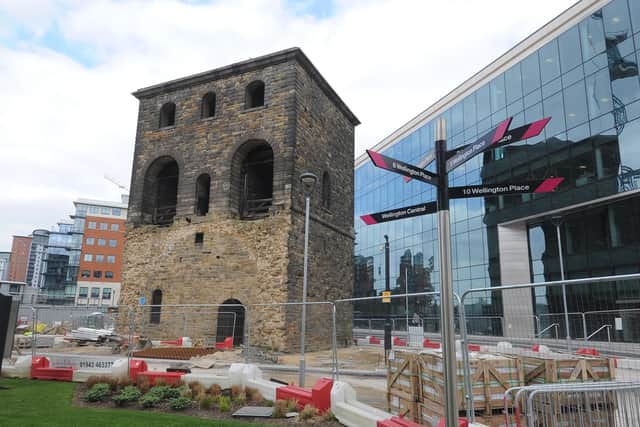Grade II-listed railway wagon hoist tower at Wellington Place in Leeds city centre to be restored and converted into museum and exhibition space
The owners of the Wellington Place office development in Leeds city centre have confirmed that the Grade II-listed lifting tower will become an industrial museum and exhibition space, and be accessible for the first time in generations.
It was once part of the goods yard at Leeds Central Station, which closed in the 1960s. The site was later used for other industries, including Doncaster Monk Bridge and the Royal Mail.
Advertisement
Hide AdAdvertisement
Hide AdThe tower will be repaired, made watertight and landscaped, and the staircase will be restored with new windows, doors and lighting.


A ‘green roof’ will be planted and the ground floor opened to the public.
Developers MEPC said: “As part of the project, MEPC will be converting the new ground floor into a mini museum and exhibition space, which will showcase the rich industrial heritage of Wellington Place and Leeds. The museum, which will be accessible to the public during the day, will focus on several themes throughout the year, including highlighting the core role that the tower played for Leeds’ original railway station, and an exhibition capturing people’s memories of the working station. It will also display special artefacts from the station’s history, including exclusive photography.”
Although it is no longer functional, the wagon hoist has been a focal point of the development’s main square since 2016. Work will be completed by the winter.
Advertisement
Hide AdAdvertisement
Hide AdMEPC head of development Paul Pavia added: “The former railway lifting tower is a symbol of the rich heritage of Wellington Place and a symbol of city’s industrial roots, it plays a central role in the development and provides an interesting juxtaposition between old and new architecture.
“These works will ensure that the lifting tower remains at the heart of the development. We’re especially excited to take this onto the next level and use the space to benefit the local community as well as those across the city and wider region.”
Built in 1850, the lifting tower was one of a pair which stood either side of the river and canal viaduct. Using steam power and large chains, its role was to hoist wagons from the higher-level passenger line down to the Great Northern goods yard at the original Leeds Central Station.
Leeds Central Station closed in 1967, and the entire complex was demolished apart from the one lifting tower. It was made a Grade II listed building and received a Leeds Civic Trust blue plaque in July 2011, making it a specific historical point of interest in Leeds city centre.
Advertisement
Hide AdAdvertisement
Hide AdIn 2019, well-known chef Gary Usher, who owns Wreckfish in Liverpool and Kala in Manchester, announced on Instagram that he wanted to turn the tower into a bistro. MEPC supported his plans, but it is believed a planning application was not submitted and the project did not progress.
The wagon hoist was linked to the high-level access viaduct that still stands today, though it has been cut off at both ends. It has recently been landscaped as a public ‘skyline’ garden as part of a separate housing and leisure development. It became known locally as Monk Bridge Viaduct due to iron and steel company Monk Bridge’s occupation of the old station site.
The tower was only narrowly saved from demolition and its 'twin' was knocked down before preservation campaigners intervened. An industrial accident halted clearance work at the site, allowing the building to be granted a reprieve before it resumed.
The site later became a Royal Mail sorting office and was originally meant to be the location of the planned 560ft Lumiere skyscraper, which was never built.
